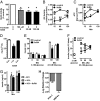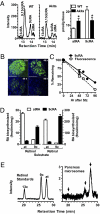Identification of 9-cis-retinoic acid as a pancreas-specific autacoid that attenuates glucose-stimulated insulin secretion
- PMID: 21115832
- PMCID: PMC3003056
- DOI: 10.1073/pnas.1008859107
Identification of 9-cis-retinoic acid as a pancreas-specific autacoid that attenuates glucose-stimulated insulin secretion
Abstract
The all-trans-retinoic acid (atRA) isomer, 9-cis-retinoic acid (9cRA), activates retinoic acid receptors (RARs) and retinoid X receptors (RXRs) in vitro. RARs control multiple genes, whereas RXRs serve as partners for RARs and other nuclear receptors that regulate metabolism. Physiological function has not been determined for 9cRA, because it has not been detected in serum or multiple tissues with analytically validated assays. Here, we identify 9cRA in mouse pancreas by liquid chromatography/tandem mass spectrometry (LC/MS/MS), and show that 9cRA decreases with feeding and after glucose dosing and varies inversely with serum insulin. 9cRA reduces glucose-stimulated insulin secretion (GSIS) in mouse islets and in the rat β-cell line 832/13 within 15 min by reducing glucose transporter type 2 (Glut2) and glucokinase (GK) activities. 9cRA also reduces Pdx-1 and HNF4α mRNA expression, ∼8- and 80-fold, respectively: defects in Pdx-1 or HNF4α cause maturity onset diabetes of the young (MODY4 and 1, respectively), as does a defective GK gene (MODY2). Pancreas β-cells generate 9cRA, and mouse models of reduced β-cell number, heterozygous Akita mice, and streptozotocin-treated mice have reduced 9cRA. 9cRA is abnormally high in glucose-intolerant mice, which have β-cell hypertropy, including mice with diet-induced obesity (DIO) and ob/ob and db/db mice. These data establish 9cRA as a pancreas-specific autacoid with multiple mechanisms of action and provide unique insight into GSIS.
Conflict of interest statement
The authors declare no conflict of interest.
Figures






References
-
- Qatanani M, Lazar MA. Mechanisms of obesity-associated insulin resistance: Many choices on the menu. Genes Dev. 2007;21:1443–1455. - PubMed
-
- Muoio DM, Newgard CB. Mechanisms of disease: Molecular and metabolic mechanisms of insulin resistance and beta-cell failure in type 2 diabetes. Nat Rev Mol Cell Biol. 2008;9:193–205. - PubMed
-
- Henquin JC, Ravier MA, Nenquin M, Jonas JC, Gilon P. Hierarchy of the beta-cell signals controlling insulin secretion. Eur J Clin Invest. 2003;33:742–750. - PubMed
-
- Lowell BB, Shulman GI. Mitochondrial dysfunction and type 2 diabetes. Science. 2005;307:384–387. - PubMed
Publication types
MeSH terms
Substances
Grants and funding
LinkOut - more resources
Full Text Sources
Other Literature Sources
Medical
Miscellaneous

